Embark on an exciting journey into the rich avian tapestry of Missouri, a state known for its awe-inspiring population of geese.
Across Missouri’s varied habitats, from its tranquil wetlands to bustling urban locales, the stories of these waterfowl unfold. Join us as we explore five of the Show-Me State’s most astonishing geese species, each adding unique hues to Missouri’s ecological canvas.
What Geese Are in Missouri?
There are five species of geese in Missouri along with two swan species.
| Goose | Frequency in Missouri | Resident Population | Specific Locations in Missouri |
|---|---|---|---|
| Canada Goose | Common | Yes | Forest Park, Squaw Creek National Wildlife Refuge |
| Snow Goose | Seasonal (Winter, Spring migration) | No | Swan Lake National Wildlife Refuge, Eagle Bluffs Conservation Area |
| Ross’s Goose | Seasonal (Winter, Spring migration) | No | Grand Pass Conservation Area, Mingo National Wildlife Refuge |
| Cackling Goose | Seasonal (Winter, Spring migration) | No | Loess Bluffs National Wildlife Refuge, Fountain Grove Conservation Area |
| Greater White-fronted Goose | Seasonal (Winter, Spring migration) | No | Ten Mile Pond Conservation Area, Schell-Osage Conservation Area |
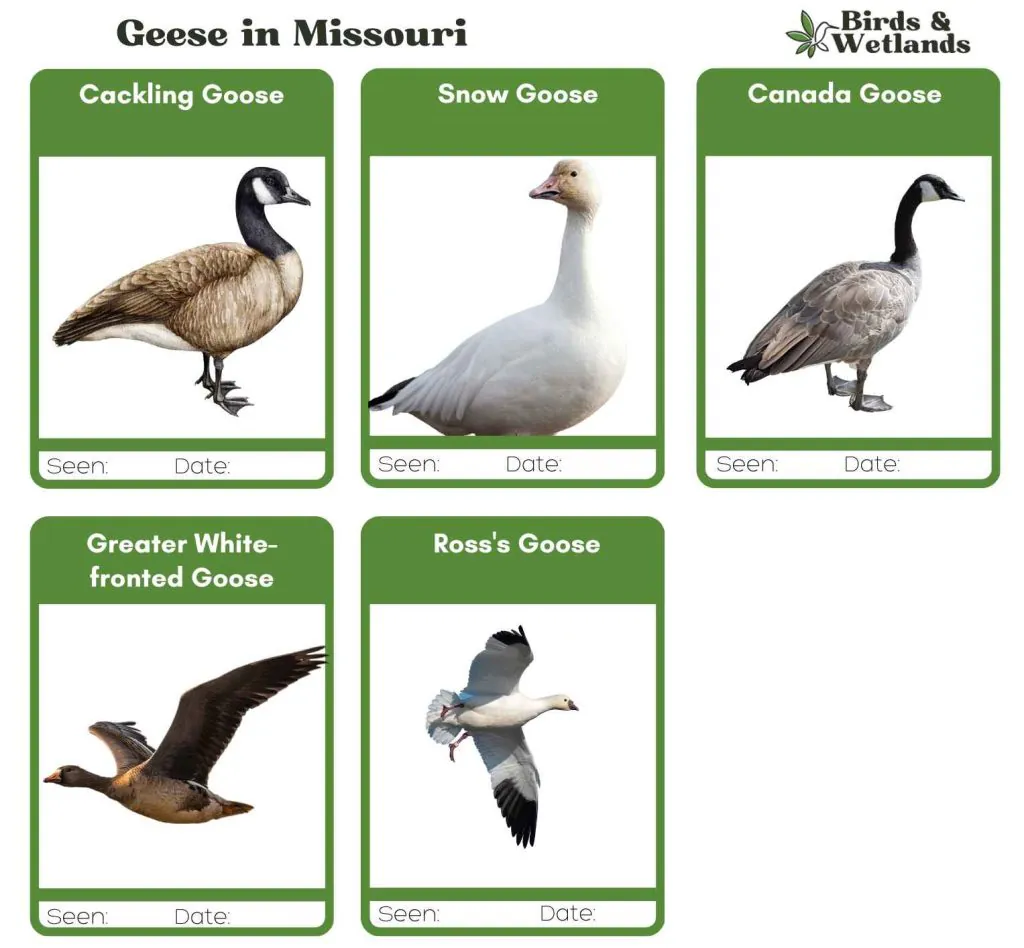
Geese Species Found in Missouri
Canada Goose
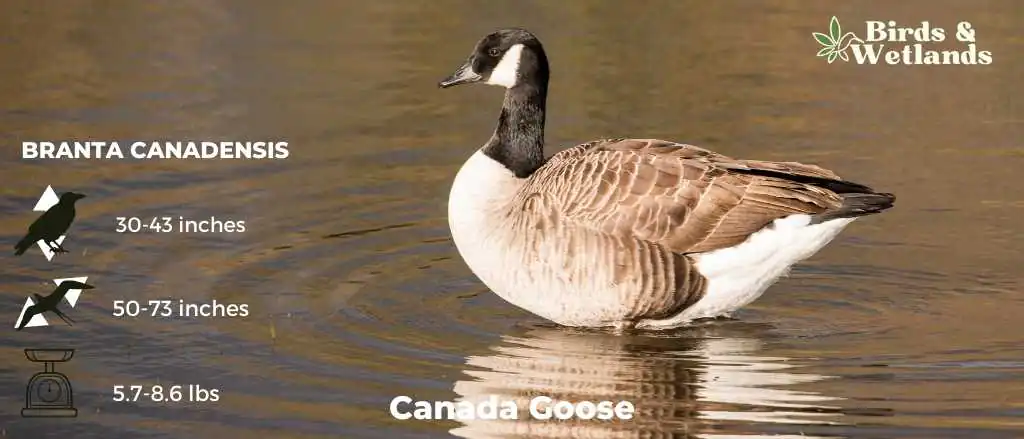

Canada Goose Sound
Scientific Name: Branta canadensis
Length: 30 to 43 in
Wingspan: 50–73 in
Weight: 5.7–14.3 lb
The Canada Goose is a large, well-known species of waterfowl noted for its distinctive appearance, familiar “honk,” and migratory behavior.
Appearance: Both male and female Canada Geese have a similar appearance, featuring a black head and neck with distinctive white patches on the cheeks and chin. The body is primarily brown with a lighter, often white, underbelly.
Diet: Canada Geese primarily feed on plant matter, including grasses, aquatic vegetation, and grains. They can often be seen grazing in parks, lawns, and fields, as well as dabbling in water bodies.
Reproduction: Canada Geese typically nest on the ground near water bodies, often on islands or other isolated areas to avoid predators. The female lays a clutch of about 4 to 6 eggs, which she incubates alone for around a month.
Snow Goose
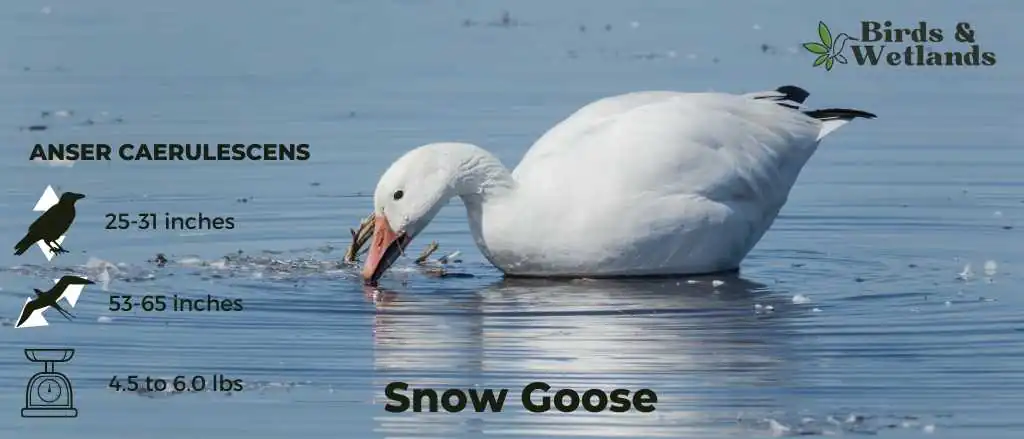
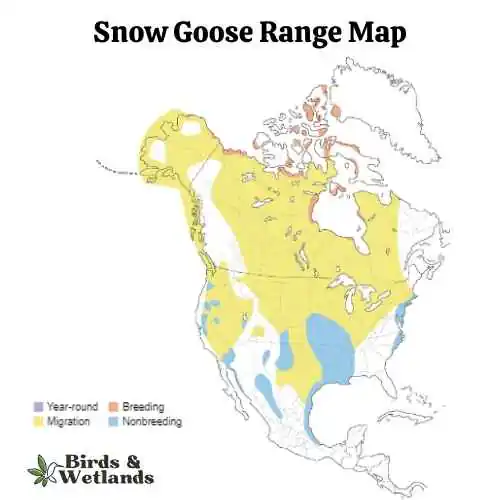
Snow Goose Sound
Scientific Name: Anser caerulescens
Length: 25 to 31 in
Wingspan: 53 to 65 in
Weight: 4.5 to 6.0
The Snow Goose is a large species of waterfowl known for its vibrant white plumage and significant migratory flights.
Appearance: True to their name, Snow Geese are predominantly white with black wingtips. They also have a pink bill, pink legs and feet. A color morph, known as the “Blue Goose,” displays a bluish-gray body with a white head, but is considered the same species.
Diet: Snow Geese primarily feed on plant matter, such as grasses, sedges, and small grains. They can often be seen in large flocks foraging in fields and marshes, and during migration and winter, they can cause considerable damage to agricultural fields due to their feeding habits.
Reproduction: Snow Geese typically nest on the tundra, near water bodies. The female builds the nest and lays a clutch of about 3 to 5 eggs, which she incubates alone for approximately three weeks. Once hatched, the goslings can feed themselves but stay with their parents for protection until they can fly.
Ross’s Goose
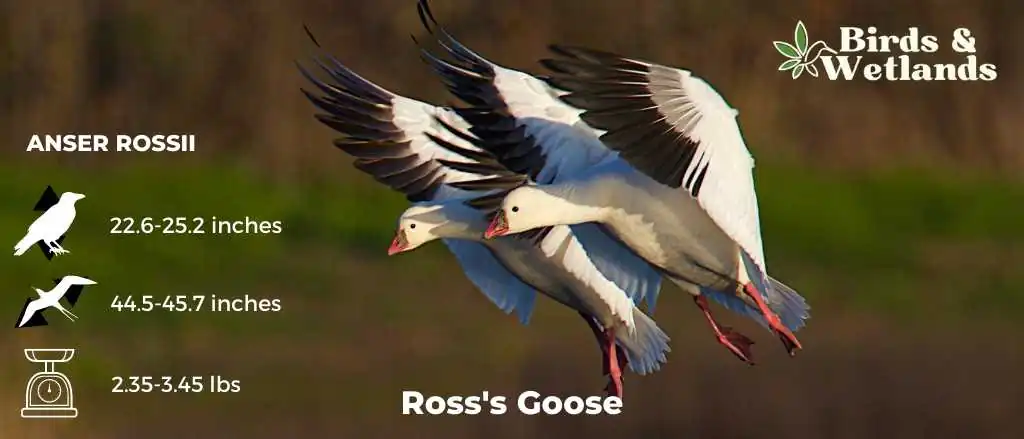
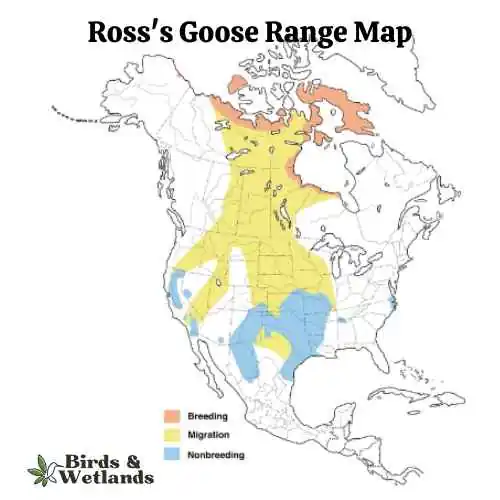
Listen
Scientific Name: Anser rossii
Length: 23.2-25.2
Wingspan: 44.5-45.7 in
Weight:42.3-55.3 oz
The Ross’s Goose is a small species of waterfowl often found in North America’s tundra and wetland habitats.
Appearance: Known for its compact size, the Ross’s Goose is mostly white with black wingtips. It features a short, stubby bill and a rounded head. One key identifying feature is the blueish gray base of its bill, which has a warty structure during the breeding season.
Diet: This goose feeds mainly on vegetation, including seeds, leaves, and roots of grasses and sedges. During winter and migration, they also consume grains and seeds from agricultural fields.
Reproduction: The Ross’s Goose nests on the ground, often in colonies. The female lays a clutch of 2 to 5 eggs which she incubates for around three weeks. The young geese, known as goslings, are precocial – they can walk, swim, and feed themselves shortly after hatching, although they stay with their parents until they learn to fly.
Cackling Goose
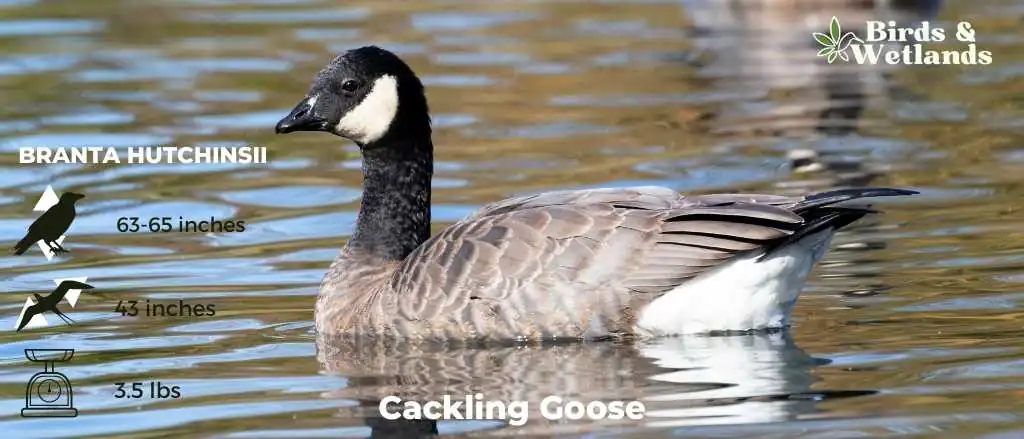
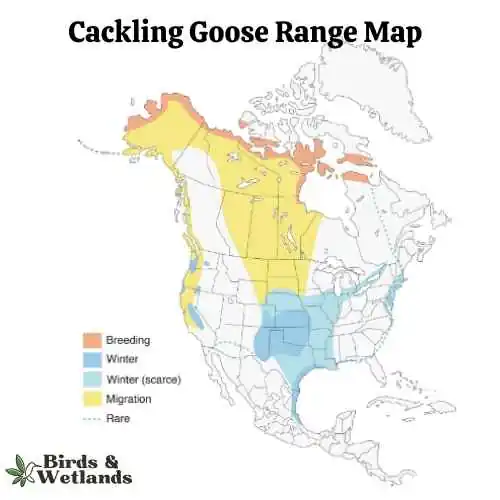
Listen
Scientific Name: Branta hutchinsii
Length: 24.8–25.6 in
Wingspan: 43-45.7 in
Weight:3.5 lbs
Cackling Geese are particularly known for their high-pitched, cackling calls, which is the source of their name. Despite their small size, these geese are renowned long-distance migrants, with some populations traveling thousands of miles between breeding and wintering grounds.
Appearance: With a similar color pattern to the larger Canada Goose, the Cackling Goose features a black head and neck, white chinstrap, light tan to cream chest, and brownish-grey body. One defining characteristic is its noticeably smaller size and stubbier neck compared to its larger counterparts.
Diet: Like many geese, the Cackling Goose’s diet mainly consists of plant matter. This includes grasses, seeds, and aquatic vegetation. They are often seen grazing on land or dabbling in shallow water.
Reproduction: Cackling Geese usually nest on the ground in elevated areas near water bodies, such as riverbanks or lakeshores. The female lays a clutch of 2 to 8 eggs and is responsible for incubation, while the male stands guard nearby. Incubation lasts for about a month.
Greater White-fronted Goose
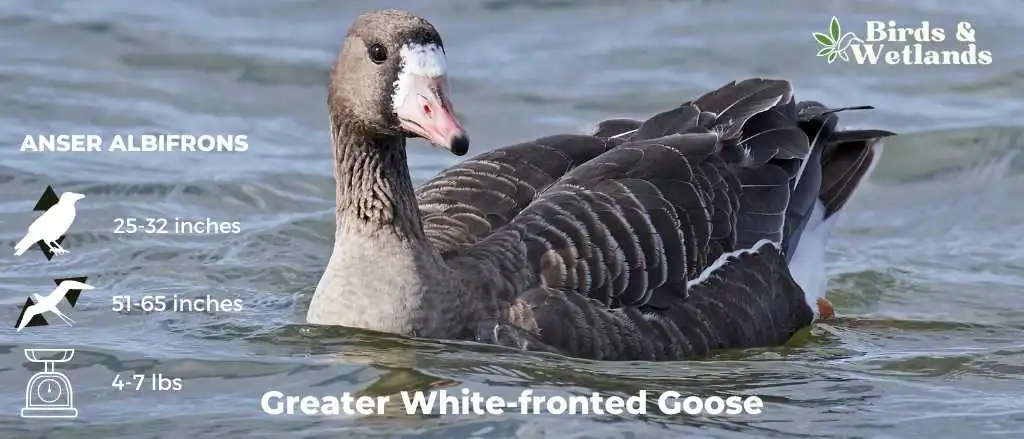

Listen
Scientific Name: Anser albifrons
Length: 25 to 31 in
Wingspan: 53 to 66 in
Weight: 3.3 to 6.6
The Greater White-fronted Goose is a medium to large waterfowl species, widely distributed across the Northern Hemisphere, particularly in North America.
Appearance: As the name suggests, these geese display a prominent white patch at the base of their bill. Their bodies are gray-brown, and their breasts are often marked with dark blotches. They possess a pinkish bill and orange legs and feet.
Diet: The Greater White-fronted Goose is a herbivore and feeds mainly on plant material. Its diet consists of grasses, sedges, grains, and berries. When wintering, these geese can often be found in agricultural fields, feasting on leftover grains and crops.
Reproduction: This species nests on the ground, often in areas with good visibility such as slopes or ridges. The female lays a clutch of 4 to 5 eggs, which she incubates for nearly a month. Once hatched, the young ones are taken care of by both parents until they are able to fly.
Where to Spot Missouri’s Geese
Squaw Creek National Wildlife Refuge: This 7,350-acre refuge in northwest Missouri is a bird watcher’s paradise, known for attracting large populations of migratory birds, including several geese species.
Eagle Bluffs Conservation Area: Situated on the Missouri River floodplain, Eagle Bluffs offers exceptional opportunities to spot a diversity of geese during their migration seasons.
Loess Bluffs National Wildlife Refuge: A 3,400-acre wetland complex, Loess Bluffs is famous for its spectacular congregation of Snow Geese and other waterfowl during winter migration.
Mingo National Wildlife Refuge: Located in the Mississippi lowlands, Mingo offers a diverse range of habitats attracting various geese species throughout the year.
Schell-Osage Conservation Area: A wetland management area with a mosaic of pools, marshes, and woodlands, Schell-Osage is a vital stopover for migrating geese.
Where to Spot Geese in Neighboring States
- Arkansas Geese | Holla Bend National Wildlife Refuge, Lake Dardanelle State Park
- Iowa Geese | DeSoto National Wildlife Refuge, Saylorville Lake
- Illinois Geese | Horicon National Wildlife Refuge, Crab Orchard National Wildlife Refuge
- Kansas Geese | Cheyenne Bottoms Wildlife Area, Quivira National Wildlife Refuge
- Kentucky Geese | Land Between the Lakes National Recreation Area, Cave Run Lake
- Nebraska Geese | Platte River, Crescent Lake National Wildlife Refuge
- Oklahoma Geese | Great Salt Plains National Wildlife Refuge, Hackberry Flat Wildlife Management Area
- Tennessee Geese | Reelfoot Lake State Park, Tennessee National Wildlife Refuge
Are There Any Resident Flocks of Geese in Missouri?
Missouri is home to a wide variety of wildlife, including several species of resident geese. The most common resident goose in Missouri is the giant Canada goose. These large birds are typically found near lakes, marshes and golf courses where they can find plenty of food and shelter.
Although giant Canada geese are not native to Missouri, they have adapted well to the state’s climate and habitat.
In recent years, these birds have become increasingly common in Missouri, much to the delight of birdwatchers and nature enthusiasts. If you’re lucky, you may even spot a giant Canada goose during a hike along one of Missouri’s many scenic trails.
Hunting Geese in Missouri
In Missouri, both residents and non-residents need to have a Small Game Hunting Permit and Migratory Bird Hunting Permit to hunt geese.
The good news is that these permits can be easily obtained online or at any Missouri Department of Conservation office.
Can You Shoot a Goose in Missouri?
Missouri offers ample opportunities for goose hunting, with a large variety of species and a season that typically runs from early October to February.
You can hunt geese in Missouri with shotguns that are 10 gauge or smaller, as well as with nontoxic shots and electronic calls. Hunting dogs are also allowed.
During the Light Goose Conservation Order, which typically runs from February to April, you may use shotguns that are capable of holding more than three shells. Missouri’s expansive season and variety of hunting locations mean that you can find success at any time of day.
Hunting geese have a daily bag of 3 and a possession limit of 9. Daily and possession limits are brant and Canada geese combined.
Where Can I Hunt Geese in Missouri?
Missouri is home to a variety of different species of geese, making it a popular destination for hunters. The best spot to hunt geese in Missouri is Squaw Creek National Wildlife Refuge.
Located in northwest Missouri, Squaw Creek is known for its large populations of snow geese and Canada geese.
In the North zone of Missouri, during the winter months, hunters eagerly await the one half hour before sunrise when they can begin their pursuit of waterfowl. With a conservation order permit in hand, they can target the abundant population of Ross’s geese and Canada geese.
Hunter education programs ensure that both youth hunters and adults are well-prepared and knowledgeable about species restrictions and conservation practices. The youth waterfowl hunting days provide a special opportunity for young enthusiasts to experience the thrill of the hunt and learn about the diversity of wildlife in the area.
Amid the serene landscapes of the middle zone, golf courses transform into havens for waterfowl during the hunting season. In the immediate presence of ponds and lakes, hunters equipped with shotguns capable of long-range shots patiently wait for their chance to hunt ducks and coots statewide.

